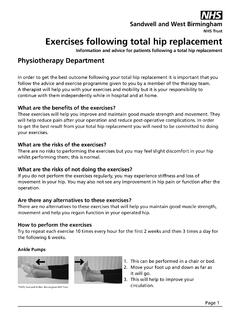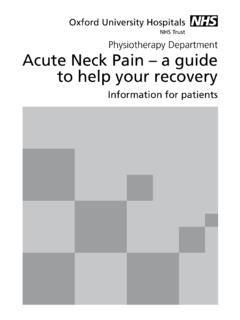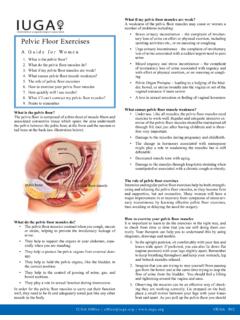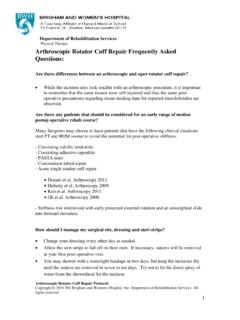Transcription of Post-Operative Laminectomy/ Discectomy Exercises
1 Post-Operative Laminectomy/. Discectomy Exercises These Exercises will help you reduce pain and recover from your back surgery Try to do these Exercises every day for the next 6 weeks Perform only those Exercises indicated and instructed by your physiotherapist Perform all Exercises within your pain limits. If the Exercises increase pain, stop the exercise and try again the next day. If you are unable to do the Exercises due to pain, consult your healthcare provider (eg. surgeon or physiotherapist). If you experience new numbness, tingling, or increased weakness, consult your healthcare provider immediately 1. A Review of Good Posture: How to Find Neutral Spine Good posture ensures your spine is in the correct position. We call this position neutral spine'. Before starting an exercise , always find neutral spine as follows: Neutral spine standing or sitting Stand with feet shoulder width apart, or sit on both sitting bones evenly Bring your spine to neutral by tightening stomach muscles to tuck your bottom in Imagine a string attached to the top of your head is being pulled up on Bring shoulder blades together and down to your back Tuck your chin slightly so that your ears are in line with your shoulders Vancouver Coastal Health Neutral spine lying on your back Lie on your back with knees bent and feet flat on the bed Make sure there is a small space between your low back and the bed.
2 Your lower back should be halfway between arched and pressed flat to the bed Imagine a string attached to the top of your head is being pulled up on Vancouver General Hospital 899 West 12th Avenue Vancouver BC V5Z 1M9. Tel: 604-875-4111. 2. Deep Abdominals Much of the stability in your lower back comes from deep muscles in your abdomen and pelvis. It is hard to feel them working and you may need some practice before you can learn to work them. Lie on your back with knees bent and feet flat on the bed, and find neutral spine Place your fingertips on each side of your lower abdomen just above your pelvis Keep your upper body relaxed and breathe gently Gently tighten stomach muscles as if trying to pull bellybutton in towards your spine. You should feel a gentle tightening under your fingertips, but no movement at the spine As you become more comfortable, try to hold the gentle contraction for longer periods of time.
3 Also try it in different positions (sitting, standing, walking). Repeat_____ times Vancouver Coastal Health 3. Diaphragmatic Breathing Your diaphragm is an important muscle of breathing that can also help with the stability of your lower back. Breathing well can help with oxygenation, relaxation and pain control. Relax your neck and shoulders Find neutral spine (this may be in lying, sitting, or standing). Place your hand on your stomach over the lower ribs Take a deep breath in and out in a relaxed manner You should feel your hand rise as you breathe in and fall as you breathe out Vancouver Coastal Health 4. Neural Glides Neural glides can stop your nerves from getting stuck or bound down by scar tissue as you heal. Sit tall with a neutral spine Keep the shoulders relaxed and directly over the pelvis. Breathe gently Slowly straighten one knee. Do not move it past any tension. Remember to keep the back and pelvis stable, in a neutral position Move your ankle slowly so you point your toes up, then down Repeat _____ times on both sides Vancouver Coastal Health 5.
4 Clamshells Strong muscles around your hips can help you adopt good posture and walking pattern. Lie on your side, knees and hips bent. Gently pull in your stomach muscles to activate deep abdominals. You can also have your back against a wall Leave your heels together, slowly lift the top knee by turning the hip out without letting your back roll or twist Only move as far as a stable back allows. Slowly return to the start position Keep breathing freely Repeat _____ times on both sides Vancouver Coastal Health 6. Knee Bends Strong legs keep you moving safely and protect your back. Knee bends can help with your balance and walking pattern. Stand with a neutral spine with hands supported on counter top or table Place your feet shoulder width apart Keep your knee caps aligned with the second toe Slowly bend your knees (30-45 degrees maximum). Slowly straighten legs, use both legs evenly Repeat _____ times Vancouver Coastal Health 7.
5 Walking Program Walking is one of the best Exercises to help you recover from the surgery. When walking, always make sure you adopt a good posture with a neutral spine. Start with frequent, short walks on level ground Each day increase the amount of time you spend walking As your walks get longer, cut back the number of walks per day. This will allow you to increase your walking time and prevent getting too tired or sore Make sure you wear comfortable clothing and footwear such as good running shoes If nervous or unsure when walking outside, walk with someone If walking with a walker, cane or poles, try to stand as erect as you can. Keep the walker close to you Progression of Exercises Before returning to sports and other physical activities, obtain permission from your surgeon When your surgeon allows you to return to your regular activities, we recommend that you see a physiotherapist to progress this exercise program We suggest you book an appointment at a physiotherapy clinic after you follow-up with your surgeon to help you rebuild your strength, flexibility and improve the stability in your lower back Getting In and Out of Bed When getting into bed: Sit on the edge of the bed.
6 Lie down on your side. Stay on your side or log roll onto your back. When getting out of bed: Bend your knees up, roll onto your side. Drop your feet off the side of the bed and push up with your hand/forearm. Avoid twisting your back. Sit briefly on the edge of the bed before standing up straight. Lifting Do not lift, push, pull, or carry anything that weighs more than 5-10 pounds. When you do lift or carry something, use two hands to keep the item close to your body; hold it between your hips and shoulders; Vancouver Coastal Health keep it centred in front of you; and do not twist your back. If you need to carry two items, keep the load balanced on each side of your body. Vancouver Coastal Health For more copies, go online at or email and quote Catalogue No. Vancouver Coastal Health, August 2011. The information in this document is intended solely for the person to whom it was given by the health care team.







